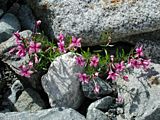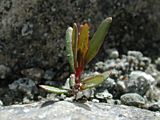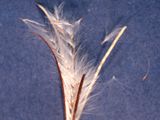Living the extremes, seeds for colonization, clonality for persistence: Epilobium fleischeri
The foreland of retreating glaciers are habitats with an extremely low resource level on bare soils containing neither a seed bank nor organic matter. Soils are mostly unsuited for germination, either cold and wet, or dry and exposed to high insolation. Epilobium fleischeri is one of the first pioneers at such sites in the Swiss Alps. It is a long-lived perennial and able to persist until late stages in the primary succession from bare soil towards forest vegetation.
The life cycle of E. fleischeri is characterized by three succeeding stages:
1. Colonisation of "safe sites"
Single individuals produce up to 60'000 tiny wind-dispersed seeds with plumes. The availability of "safe sites" for germination is crucial for the plant. Germination on suitable "safe sites" is early after snow melting, growth is rapid. Already in the second year newly established plants may flower and set seeds.
2. Colonization of new sites by clonal growth
In their third year of an individual plant, E. fleischeri produces long horizontal roots with buds that are able to form new shoots. Thereby sites, where establishment by seeds is unlikely, are colonized. E. fleischeri is morphologically highly variable. In early pioneer vegetation single shoots or cluster of few shoots prevail.
3. Growth and persistence
Older plants of E. fleischeri may form large clusters with many shoots. When competition in later successional stages becomes important, the plant is able to avoid it by fugitive growth, again by forming new shoots from root buds. This morphological plasticity of E. fleischeri plays a crucial role for the persistence of this species in older successional stages on glacier forelands.





